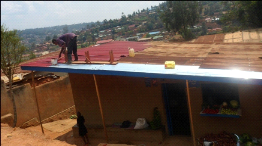4.3 Planning
implications of Amahoro cell
According to Kigali city subarea master plans, Amahoro cell
like other parts of Muhima sector is planned for multi-storey buildings for
commercial and institutional services (commercial business district, CBD).
Currently, Amahoro cell is occupied by informal residential houses with
unsustainable building materials. According to the level of income of the
residents in Amahoro cell where 68% of the households earn less than 50,000
Rwandan francs per month, they are not able to construct houses that comply
with the required standards.
In 2008, Kigali city council valuated immovable properties of
residents in both Ubumwe and Amahoro cells. However, Ubumwe residents were
compensated and resettled to Batsinda (a housing project initiated by Kigali
city council, Rwanda Social Security Board and Rwanda Housing Bank) but
residents in Amahoro cell were not paid.The cell executive secretary said that
after expropriating Ubumwe cell residents, the city council saw that the
acquisition of plots by investors was slow and decided not make more mass
expropriations. When an investor needs to acquire land, then he/she
expropriates the land owners occupying the surface area that he wants to cover.
According to law No. 18/2007 of 19/04/2007 chapter 3, section3, article17
relating to the expropriation in public interest, `The owner of the land is not
allowed to carry out any activities after the land survey and the inventory of
the properties thereon and coming to terms with the beneficiaries. In case he
or she carries out any activities, they shall not be valued in the process of
expropriation'. This hindered residents who were able to upgrade their houses.
Time came when this step of land survey and inventory of the properties towards
compensation and relocation lost validity. But residents are still bound by the
regulation of Kigali city council which states that no new building should be
erected in the area without prior authorization from the district which
confirms that the building conforms to the requirements by the master plan.
Upgrading the house by changing the shape and size of the building is not
acceptable and any upgrading is authorized by the district.
However, recently Kigali city council took a decision to
improve the city's sanitation and physical outlook by mobilizing all residents
to remove all stones, metallic objects and other woody materials that were put
on roofs to support old iron sheets and paint them (photo 6). These measures
are taken to keep the city clean while in the transition of implementing Kigali
conceptual master plan.
Photograph 6: House under roof
painting

Source: Author, 2011
4.4 Resident's
perception on informal housing upgrading and master plan implementation
Urban renewal involves upgrading of the existing urban
buildings and structures or clearing the existing informal settlements for new
developments. The latter is planned to be implemented in Amahoro cell according
to the subarea master plan of Muhima sector. One of the objectives of this
research was to assess Amahoro residents' perception on this renewal envisaged
in the master plan and what they would demand if susceptible to expropriation
or relocation.
4.4.1 Perception on Kigali master
plan
Generally residents admit that the nature of housing in their
neighborhood is not good depending on the sustainability of the building
materials, minimum parcel size and basic infrastructure provision and
accessibility. About 73% of the surveyed households responded that the nature
of housing in their neighborhood is poor while only 27% said that their
neighborhood is good in terms of housing development (table 5).
Surveyed households said that they have heard about Kigali
conceptual master plan and that their neighborhood will be developed into a
business centre with multi-storey buildings. They also said that KCMP is one
way and a step towards achieving Rwanda's vision 2020 for its citizens. They
further said that its implementation will lead to the country's overall
development through enhancement of commercial services and extension of both
physical and social infrastructure.
However, they added that the implementation of the master plan
will displace them to the city's periphery which will hinder accessibility to
their jobs in the city centre.
Table
5: Residents' judgment on the sustainability of building materials in their
neighborhood
|
Question
|
Response
|
Frequency
|
|
Nature of housing in the neighborhood depending on the
sustainability of building materials
|
Poor
|
73
|
|
Good
|
27
|
|
Total
|
100
|
Source: Household survey,
2011
| 


